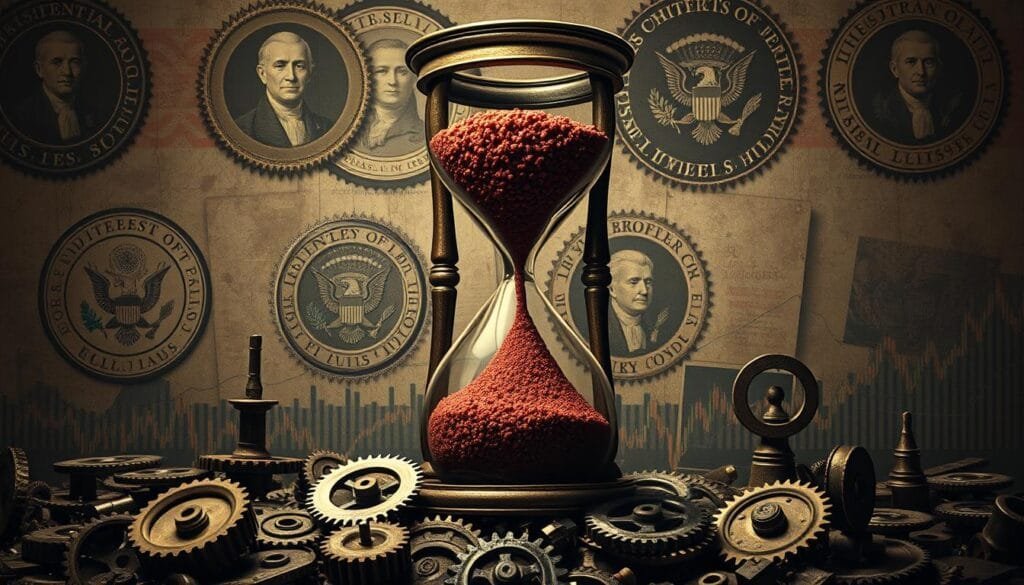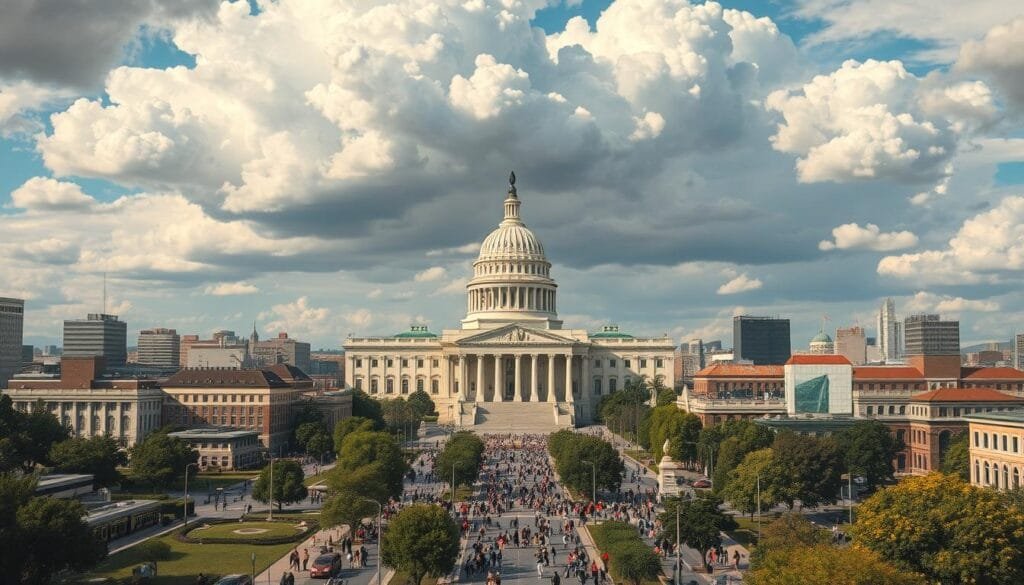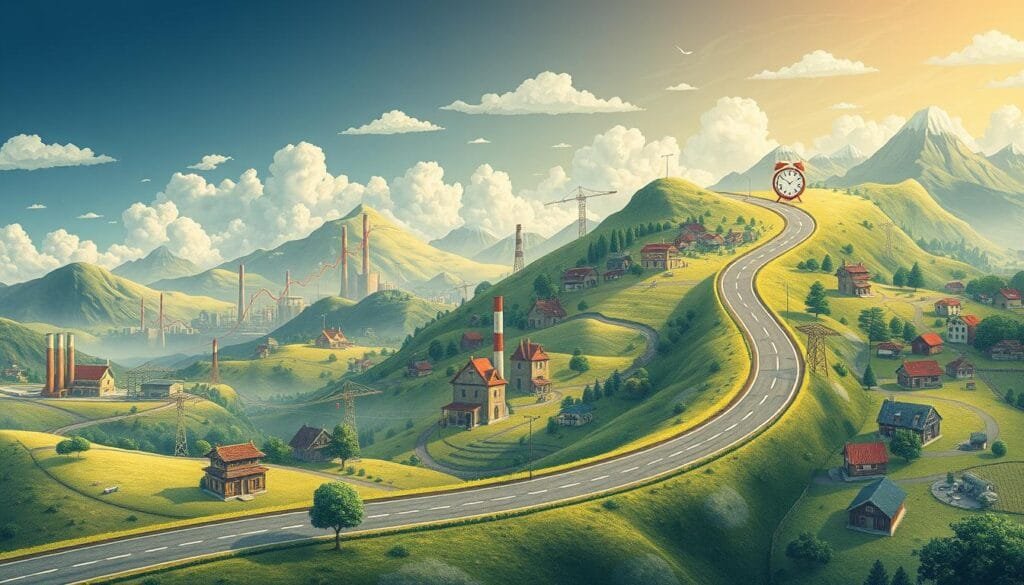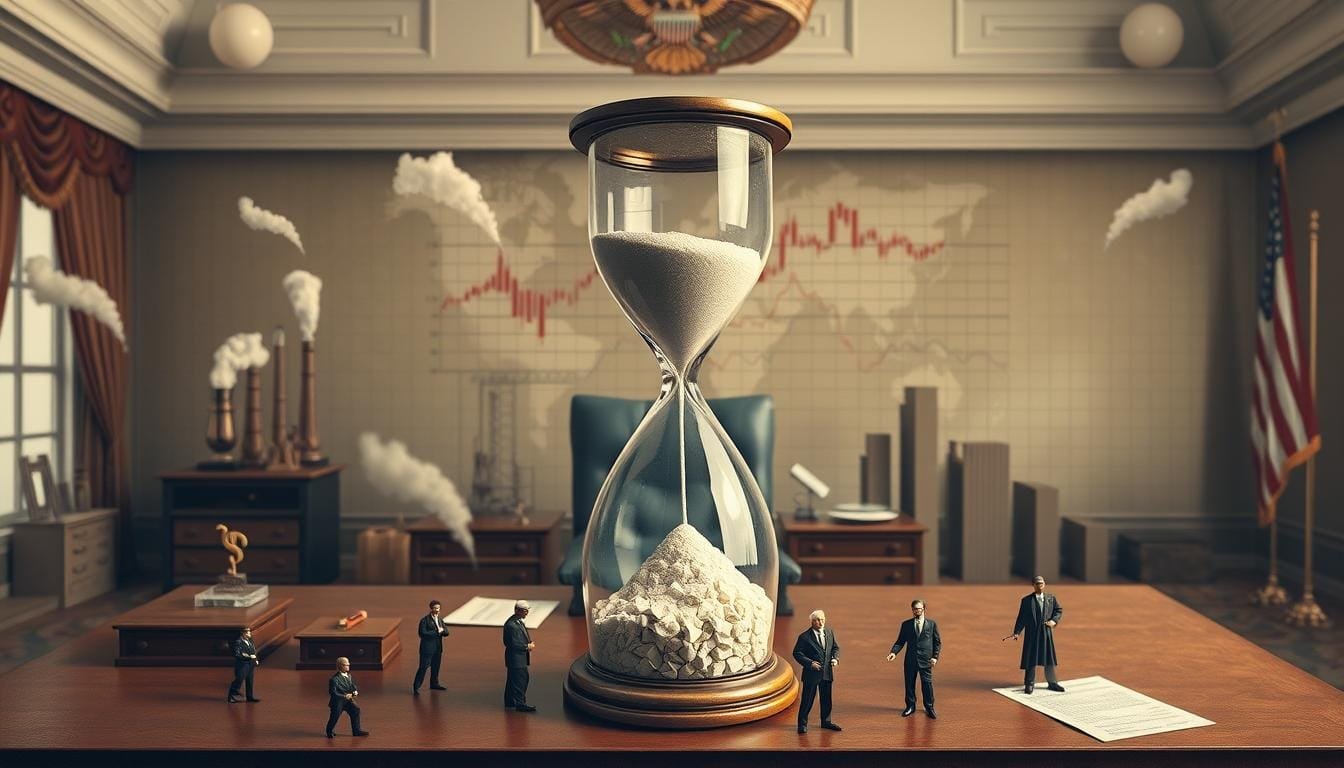We often think the economy’s ups and downs are because of the president. The link between presidential economic policy and economic impact might not be direct. U.S. presidents’ policies usually show effects later, making the situation complex.
For example, President Obama’s stimulus package aimed to speed up economic recovery. On the other hand, President Nixon’s price controls showed that fast moves can backfire.
Usually, the real effect of a president’s economic actions takes time to show. The economy moves slower than the news suggests. So, we need to look back in history to get the full picture.
Key Takeaways
- Presidential policies usually have a delayed effect on the economy.
- Economic measures by presidents are more noticeable during crises.
- The actual economic impact of a presidential term may only become clear years later.
- Presidential actions can have both immediate and long-term economic consequences.
- Understanding the true presidential economic policy effects requires analyzing data over extended periods.
The Illusion of Immediate Impact
Many people believe that presidential power can quickly change economic growth. They think presidents can stabilize the economy fast. But economic cycles and economic stimulus work slowly. Changes in policy, especially big ones, take time to show results. Often, these effects are seen long after a president’s term ends.
Limited Presidential Control Over the Economy
A president’s control over the economy is limited. Actions like economic recovery plans need time to work. For example, Joe Biden’s plans aim to put five trillion dollars into the economy. However, the benefits, such as more jobs and stability, will slowly appear over the next ten years.
The Real Economic Levers Are Slow to Move
Economic changes don’t happen overnight. Plans to improve infrastructure and clean energy will reshape our industry and fight recession. But it will take a long time. The move to electric vehicles, including efforts like the Clean School Bus Program, is a huge investment. These changes will unfold over many years, showing a careful transformation, not a quick fix.
Historical Economic Cycles and Timing
Economic patterns often repeat, not always because of what presidents do. After the pandemic, steps were taken to lower unemployment. The American Rescue Plan injected $1.9 trillion to help. However, these actions are part of larger economic cycles. They demonstrate timing is crucial in economic policy success.
| Year | Unemployment Rate | Economic Stimulus |
|---|---|---|
| 2021 | 3.9% | $1.9 trillion (American Rescue Plan) |
| 2022 | Below 4% | Pending impact of fiscal policies |
| 2023 | Projections | Continued investments in infrastructure |
To sum up, we need to understand the slow pace of policy effects and economic cycles. Presidential actions and economic theories make it clear. The real impact of economic policies will be seen long after current politics are forgotten.
Why Are Economic Changes Taken by Presidents Delayed
To understand why economic policy delay often follows presidential actions, we must examine the complex processes of governance and external factors. These policies need time to show results because they go through many steps before impacting the economy.

The timeline for policy impact is long partly because of the need for approval by both legislative and sometimes judicial branches. This, combined with global market changes and foreign policies, affects the economy’s response to presidential orders.
For instance, proposals for job creation or tax changes must navigate through various governance levels. While a president can suggest measures to improve the economy, like stimulus packages, seeing these effects takes time.
The majority of day-to-day economic decisions in a market economy are made by business people in companies and individuals in households, indicating that the federal government, despite its influence, does not operate in isolation.
A study on presidential economic management shows that while presidents can shape public perception and propose key initiatives, the actual economic outcomes result from lengthy processes and broader economic cycles that transcend any single administration.
| Presidential Term | Unemployment Rate Change | Average Real GDP Growth |
|---|---|---|
| Bill Clinton | -3.1% | 3.9% |
| George W. Bush | +3.6% | 2.1% |
| Donald Trump | +1.7% | 1.0% (Affected by pandemic) |
In conclusion, while presidents aim to make fast changes through economic policies, the reality is different. The economic policy delay and the need to navigate complex governmental and global systems mean impacts are felt later. This ensures that changes, when they occur, are thoroughly vetted and beneficial in the long run.
The Role of Congress in Economic Policy
In the U.S., congressional influence is key to shaping economic policy, working hand in hand with the president. An important example of this is in creating economic legislation. The success and direction of the president’s economic plans often depend on which party controls Congress. Government spending and policy making by Congress meet both immediate and long-term economic goals.

History shows the importance of the relationship between the president and Congress, especially during economic crises like the Great Recession of 2007. In these times, the Federal Reserve helps, but strong moves from government spending decided by Congress are crucial. Laws passed more easily under a unified government can lead to quicker recovery, improving job numbers and infrastructure.
- Composition of Congress: Affects how deeply economic laws can be made, changing things like worker rights and income spread.
- Presidential Alliance: A president with the same party in Congress can move policies forward faster. A divided government might face slowdowns from veto threats.
- Economic Impact of Government Spending: Spending on social services and infrastructure has a bigger effect on recovery than tax breaks for the rich.
The varied roles of Congress in our economic system show the fine balance of power and the need for working together in policy making. Understanding the deep effects of congressional influence and legislative actions is crucial. It helps create a setting where our economy can grow fairly and sustainably.
Impact of Long-term Policy Implementation
When we look into long-term economic policy, we see its deep and lasting effects. Trade policies, regulations, and financial strategies all play a big part. Looking at examples from recent leaders helps us get the full picture of their effects on the economy.
Trade Agreements and Their Gradual Effects
Trade policies take time to show their full impact. For instance, a 10% tariff on imports changes prices and trade relationships slowly. Over time, these policies alter our economic scene by changing trade connections and market competition worldwide.
The Slow Influence of Regulation Changes
Regulatory changes are key in shaping our economy over the long haul. It can take years for these adjustments to be absorbed by the economy. For example, cutting back on regulations affects healthcare and energy sectors a lot. This changes costs and how businesses operate gradually.
Ripple Effects of Fiscal Policies
Tax policies, like credits or law changes, slowly influence the economy too. Think about a $25,000 tax credit for first-time homebuyers. This could give the housing market an initial boost, but the wider impacts, like more homebuyers and more building, unfold over time.
The table below shows some key financial moves suggested by different leaders and how they could change our economic landscape:
| Policy | Proposed By | Expected Impact |
|---|---|---|
| Tariffs on Imported Goods | Republican Party | Increase in domestic production |
| $25,000 Tax Credit for Homebuyers | Democratic Party | Stimulation of the real estate sector |
| Enlarged Child Tax Credit | Democrats | Support for family finances |
| Exemption for Tipped Income | Trump and Harris Campaigns | Reduction in tax burden for service employees |
Crafting and enacting trade, regulatory, and fiscal policies shows the complexity of guiding our economy. While immediate effects might be hard to see, the long-term results shape our economic future for many years.

Conclusion
As we study policy effects over time, we see that changes made by U.S. presidents don’t happen right away. These delays are part of the process and often result from factors outside the president’s control. From President Biden’s efforts in vaccination to tackling job losses and long-term unemployment, we learn government actions take time.
But, the future looks promising. Experts predict lower unemployment rates and a decrease in poverty. This tells us there’s hope even when progress seems slow.
To understand a president’s impact on the economy, we need to look at the big picture. It’s not just about quick wins but about guiding the nation through challenges for long-term success. Efforts to reduce unemployment and grow the economy show how small steps can lead to big changes. Investments in infrastructure and moving people out of poverty are proofs of gradual yet meaningful progress.
When it comes to politics, we need to keep our expectations realistic. Real change takes time and cooperation, especially between the president, Congress, and the Federal Reserve. We should judge actions, like immigration reforms and initiatives for job and wage growth, by their long-term benefits. This is how we can truly understand and measure our nation’s economic health.
FAQ
What factors contribute to the delayed impact of presidential economic policy?
A few things slow down the effect of presidential economic policies. It takes time for policies to start working. Economic cycles and global trade also play a role. The Fed and other institutions have an impact too.
What happens worldwide affects our economy. Foreign trade policies and worldwide changes are big factors.
Why is the perception of a president’s immediate economic impact often misleading?
The idea that presidents quickly affect the economy is wrong. Fiscal policies and regulations take time to work. Economic growth also depends on cycles beyond a president’s control.
The economy’s complex nature means changes are slow. People wrongly think presidents can change things fast.
How significant is the role of Congress in shaping economic policy?
Congress is key in making economic policies. It decides on spending and laws. The party in control affects the president’s economic plans.
Congress can pass laws that change the economy. Decisions on taxes and spending shape our country’s future.
What is the impact of trade agreements on the economy over time?
Trade agreements change the economy slowly, over many years. Each one has a small effect. But together, they shape economic growth and trade.
These agreements need time to blend into the economy. This allows for careful adjustments in the markets.
How do regulation changes and fiscal policies affect the economy incrementally?
Changing regulations is a slow process. It involves updating rules and waiting for markets to adapt. Fiscal policies, like tax changes or spending on projects, also shift the economy slowly.
The full impact of these policies shows only after significant adjustments in the economy.
How do presidential actions impact the economy during crises versus non-crisis times?
In crises, presidential actions swiftly affect the economy. Economic stimuli during recessions can reduce damage. But in calmer times, the impact is more gradual.
Outside of crises, presidential policies set a direction. Yet, their quick effects are limited.
